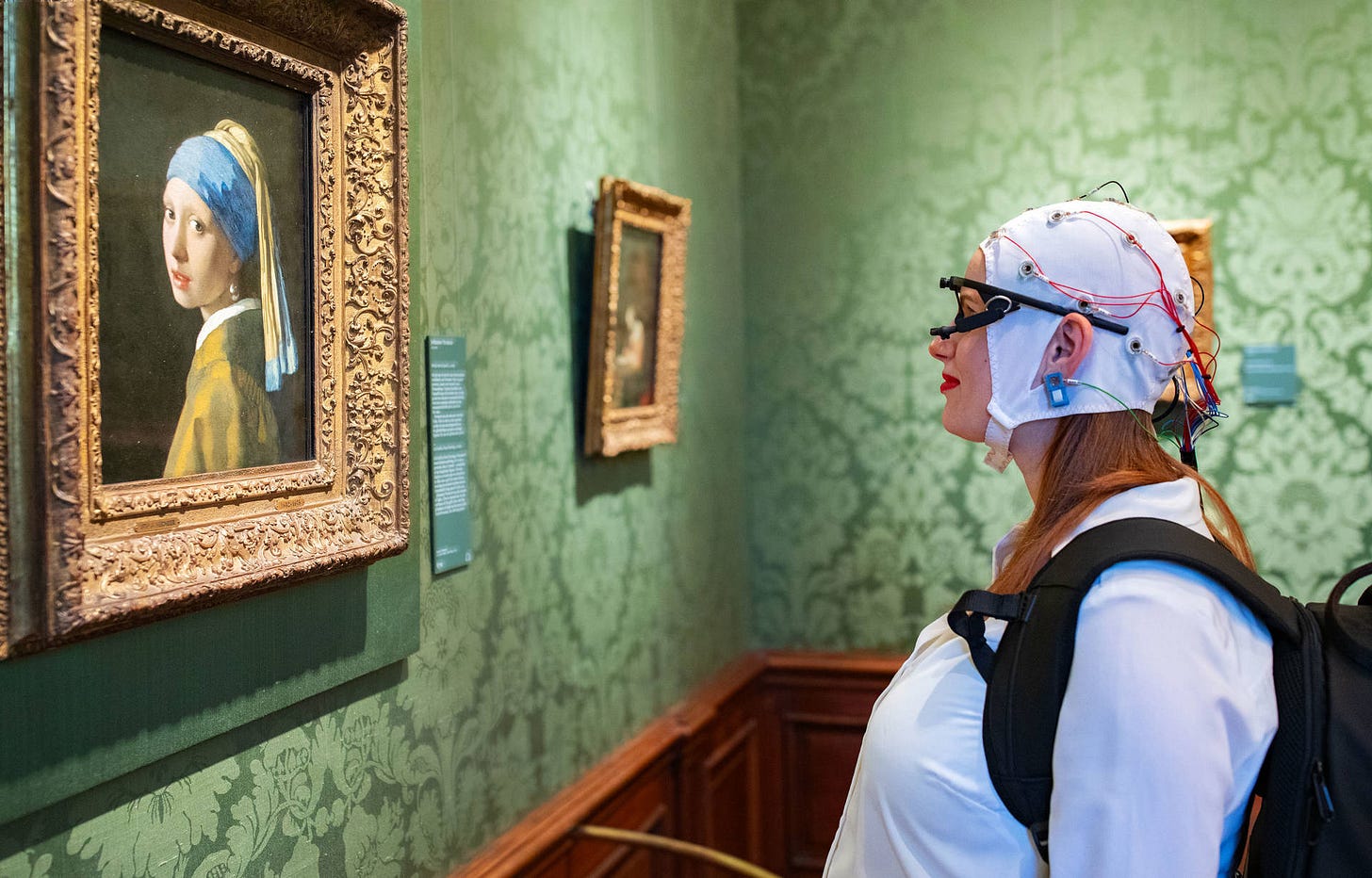Why are Museums the Ultimate Therapy Space?
A Grad Student's Perspective on the Scientific Theories that make Museotherapy Feel like Modern Magic
I never believed in epiphanies, until the afternoon I found myself alone beneath the soaring glass ceiling of the High Museum of Art in Atlanta. I traveled from Dallas to Atlanta to tag along for my husband's work trip, and I was thrilled to explore the city by myself for the weekend. The first day, I found myself at the stunning High Museum. The warm Georgia sun streamed through the skylights in golden shafts, illuminating a single painting by Culverhouse that caused the candlelit glow from the scene of the night market to come to life. In that hushed, cathedral‑like gallery, I felt the anxieties about exploring a city alone, and the hum of everyday life dissolve into the polished marble floor. As I stood wondering about the lives of the people shopping at Culverhouse’s night market, time folded in on itself, and for a moment I was having something of an almost religious experience. In that moment, I deeply understood a sentiment my art history professor stressed repeatedly in her lectures during my undergrad, art feels different in person. What if that moment of sacred stillness, the gentle tug of fascination, the architectural embrace of space, the silent companionship of strangers, could be more than a one‑off experience? What if museums, with their curated light and resonant halls, are in fact the perfect stage for art therapy’s transformational work?
Moonlit Market by Johann Mengels Culverhouse (American, born Holland, 1820–1891)
These are the questions the early pioneers of museum art therapy sought to answer. In fact, Dr. Debra Linesch’s (2004) transformative encounter with the Friedl Dicker‑Brandeis exhibition at the Museum of Tolerance changed her career. As she stood before works created under the unimaginable duress of the Holocaust, she felt the electric potential of those walls, she realized museums could hold more than history, they could hold healing. But what is the science behind museums being such perfect spaces for art therapy? Now this is a complex question, that I am probably not qualified to answer but as someone who is still a student of art therapy and spends a significant amount of time reading research and pestering the Penn West University librarian (Tonya if you're reading this, thank you), I found these three theories to be the ideas that made the everyday magic of museums click for me: Falk and Dierking’s (1992) work on the museum experience model, Attention Restoration Theory (ART) developed by Kaplan and Kaplan (1989), and the vast body of work on neuro-aesthetics presented by Magsamen and Ross (2023) in their book Your Brain on Art.
It begins with understanding that a museum visit isn’t a passive stroll past pretty pictures. In 1992, John Falk and Lynn Dierking created foundational research by showing that every museum experience unfolds across three interwoven layers: the personal, the social, and the physical context. Your own history, motivations, and emotional state color what you see. Next your companions and the conversations you share shape how you interpret it, and the very architecture of the gallery, its lighting, layout, and pacing, directs your attention and mood (Falk & Dierking, 1992). Imagine guiding a visitor toward a striking portrait. If I was in my own therapist’s office, she would ask me to close my eyes, recall a memory, and ask the very familiar question, “how does that make you feel?” But in a museum, that question dances across all three contexts at once. The artwork’s color palette starts subconsciously communicating emotional information to the viewer, then a whispered comment from a fellow participant can spark a new insight, and the gentle hush of the gallery invites a level of peaceful focus that simply doesn’t exist in a clinical office. By orchestrating movement through these layered contexts, art therapists can harness the museum’s built‑in choreography to create deeper meaning making.
If Falk and Dierking explain the museum model’s impact, Rachel and Stephen Kaplan explain to us why that model restores our minds. In their Attention Restoration Theory (ART) (1989), the Kaplans describe how certain environments naturally replenish our capacity for directed attention, a resource that modern life constantly depletes. They identified four hallmarks of restorative settings: a sense of “being away” from daily stressors, effortless fascination that engages without strain, an extent or coherence that immerses the visitor, and compatibility with the individual’s needs. A museum, with its peaceful corridors, captivating artworks, and thoughtfully arranged exhibits, delivers all four (Kaplan & Kaplan, 1989; Kaplan, Bardwell, & Slakter, 1993). Walk into a gallery and you’re immediately “away,” free from buzzing phones and email pings. Your eyes catch on brushstrokes or sculpted forms that hold your gaze without demanding conscious effort, that’s the fascination element. The curated sequence of rooms creates a narrative flow, providing “extent” that feels like stepping into a different world. And whether you’re offered a sketchbook station, an audio guide, or a quiet bench, the space adapts to your preferred mode of engagement, creating compatibility. These restorative elements aren’t extras but the very fabric of museum design.
And yet, it’s not just the quiet hush of a gallery that seeps into our psyche, it's all-encompassing from the curve of a staircase to the hue of a wall. As Magsamen and Ross (2023) remind us, our surroundings act on us beneath conscious awareness, with color palettes subtly shifting mood and architectural proportions guiding our posture and breathing. Recent EEG data from the Mauritshuis shows that viewers’ emotional responses are ten times stronger when standing before the original Girl with a Pearl Earring versus viewing a reproduction, which is amplified by the museum’s lighting, framing, and spatial ambiance. fMRI scans further reveal that encountering the real painting stimulates the precuneus, a hub for self‑reflection and episodic memory, and sustains an attentional loop that cycles between the sitter’s eyes, mouth, and iconic pearl. The very architecture falls under neuro-aesthetics because high‑ceilinged rooms, common in gallery spaces, have been shown to foster openness and creative thinking. Museums don’t just display art but they craft an immersive stimulus field, calibrated to nudge us toward the very cognitive and emotional states that healing art practices seek to evoke.
Salom (2011) takes us one step further in reminding us that “the setting carries an important role in goal attainment in art therapy.” Drawing on Bitgood (2002), she describes museums as “informal learning institutions” where visitors navigate a buffet of stimuli by choosing where to place their attention, making social connections, and delighting in discovery. Every museum, Salom argues, has its own character, which is shaped by its people, its space, its collections, and its exhibits. The museum itself can act as a co‑leader in the therapeutic process, almost like another group member whose personality influences the therapeutic journey. Thinking of the museum itself as an active partner, and an environment that reflects aspects of self or community, further helps define its crucial role in shaping both the goals and outcomes of art therapy sessions.
When you weave together Falk and Dierking’s three contexts with the Kaplans’ restorative ingredients, the new research emerging from the field of neuro-aesthetics, and Salom’s vision of the museum as co‑therapist, the result is nothing short of magic. Museums become living laboratories for art therapy, where personal stories, social connections, and environmental design converge to rejuvenate attention, spark creativity, and deepen emotional insight.
References
Falk, J. H., & Dierking, L. D. (1992). The Museum Experience. Routledge. https://doi.org/10.4324/9781315417899
Kaplan, S., & Kaplan, R. (1989). The visual environment–public–participation in design and planning. Journal of Social Issues, 45(2), 59–86. https://doi.org/10.1111/j.1540-4560.1989.tb01533.x
Kaplan, S., Bardwell, L. V., & Slakter, D. B. (1993). The museum as a restorative environment. Environment and Behavior, 25(6), 725–742. https://doi.org/10.1177/0013916593256004
Linesch, D. (2004). Art therapy at the Museum of Tolerance: Responses to the life and work of Friedl Dicker‑Brandeis. Arts in Psychotherapy, 31(2), 57–66.
Magsamen, S. H., & Ross, I. (2016). Your Brain on Art: How the Arts Transform Us. MIT Press.
Salom, A. (2011). Reinventing the setting: Art therapy in museums. The Arts in Psychotherapy, 38(2), 81–85. https://doi.org/10.1016/j.aip.2010.12.004
Solomon, M. (1954, June). The art museums. Poetry Magazine, 84(3), 9. Retrieved July 29, 2025, from https://www.poetryfoundation.org/poetrymagazine/browse?volume=84&issue=3&page=9
Mauritshuis. (2024, October 2). Girl with a Pearl Earring visually captivates the viewer [Press release]. Mauritshuis.



